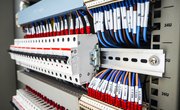You may imagine police vehicles and ambulances rushing through town, sirens wailing and lights flashing when you think of emergency lights. But lights attached to official vehicles that signal an emergency are distinct from the notion of lights within fixed structures that can be used when the usual power supply is interrupted for some reason.
This kind of lighting is by definition part of a back-up system; if it were used all the time in everyday scenarios, the whole concept of an emergency would be diluted to the point of meaninglessness. Instead, emergency lighting is used to keep the pace of life moving at as close to 100 percent as possible in critical locations (e.g., hospitals).
What Qualifies as a Lighting Emergency?
If you have ever been in a building with a lot of other people and been asked to evacuate, even if you know it is a drill, you may have considered how difficult the task might be in the dark. And if it's dark, it is likely to be a genuine emergency of some sort.
Perhaps emergency lighting's most important function is allowing people to locate the exits of a building that would otherwise be unlit, and allowing for the coordination of rescue and other efforts inside such a place.
Consider the number of places people gather under a single roof: Office buildings, theaters, churches, department stores, warehouses, government installations, industrial facilities – it takes little imagination to picture the kinds of things that could go wrong without a source of illumination when the usual power supply is compromised.
How Emergency Lights Work
In order for a seamless transition to an emergency lighting source to happen, first, the backup source must have a guaranteed power source. This is typically accomplished by using a battery that is kept charged continuously by the building's main power supply. If the power goes out, a large, fully charged battery can usually keep adequate power going for long enough to deal with whatever emergency prompted the power outage.
Some larger buildings require more than basic battery power for emergencies, so they have backup generators that can power the primary lights (sometimes to a limited extent) while also keeping all onsite batteries charged as sort of a third layer of protection against gloom.
Are those classic red "EXIT" signs are considered emergency lighting? They are in the sense that they are lit during emergency situations, but they are also on the rest of the time if everything is working correctly.
Parts of Emergency Lights
The main components of an emergency light are a housing of some sort (often but not necessarily box-shaped), a battery, a circuit board and a transformer. The battery supplies the power to the bulb or bulbs that emit the light, while the circuit board and transformer serve to recharge the battery since it is no longer being charged by the facility's primary power source.
The advent of longer-lasting batteries such as those made from nickel-cadmium has prompted some changes to the emergency-lighting world. In particular, fluorescent lights are sometimes used. The overall effect is to prolong the battery's potential lifetime to two to three years, which should be long enough so that a routine inspection should signal the need for a replacement.
Testing Emergency Lighting
It would make little sense to have emergency equipment that may not work, so inspections are probably more frequent than you might think; one per month is standard for the checking of both emergency lights and exit signs. The lights are tested for 30 continuous seconds, which in most cases is enough to expose a problem that might not be evident with just a brief lighting test.
References
Resources
About the Author
Kevin Beck holds a bachelor's degree in physics with minors in math and chemistry from the University of Vermont. Formerly with ScienceBlogs.com and the editor of "Run Strong," he has written for Runner's World, Men's Fitness, Competitor, and a variety of other publications. More about Kevin and links to his professional work can be found at www.kemibe.com.
